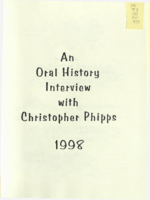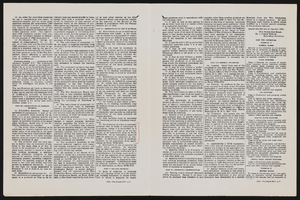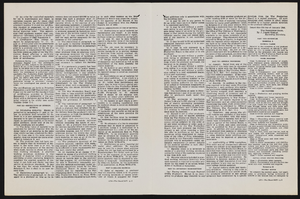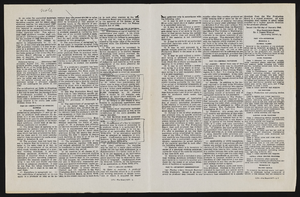Search the Special Collections and Archives Portal
Search Results
Six Companies, Inc. Hoover Dam Photograph Collection
Identifier
Abstract
The Six Companies, Inc. Hoover Dam Photograph Collection (1931-1935), consists of approximately 400 black-and-white photographic prints contained in two photograph albums and an additional twenty-one loose black-and-white photographic prints with ten corresponding photographic negatives.
Archival Collection
University of Nevada, Las Vegas School of Nursing Records
Identifier
Abstract
The University of Nevada, Las Vegas School of Nursing Records (1950-2019) contain records documenting the history of the UNLV School of Nursing. The materials include records from the nursing school's Alumni Association, including financial reports, bylaws, correspondence, and membership information; recruitment materials from the School of Nursing, including brochures, photographs, and program requirements; history of the School of Nursing, including photographs, newspaper clippings, a short summary of the program, and a short documentary film comprised of digital video files; and accreditation information, including newspaper articles, accreditation reports, and evaluations of the program from the Nevada State Board. The materials also include nursing student uniforms, caps, and nursing capes from the 1950s and 1960s.
Archival Collection
Shar Rednour and Jackie Strano Papers on S.I.R. Productions
Identifier
Abstract
The Shar Rednour and Jackie Strano Papers on S.I.R. Productions (1981-2015) contain the personal and professional papers of Rednour and Strano, two lesbian filmmakers, writers, and activists from the 1990s until the 2010s. The collection contains the personal papers of both Rednour and Strano, including correspondence between the pair before they married in 2006. The collection also contains the professional files of Rednour and Strano in their capacity as creators of SIR (Sex, Indulgence, and Rock and Roll) Video in 1998. Materials include financial documents, correspondence, scripts and editing notes, crew information, publicity photographs, and direct order forms for S.I.R. Productions. In addition to records on SIR Video, the collection also contains a number of sex-positive and lesbian, gay, bisexual, transgender, and queer (LGBTQ) publications from the LGBTQ scene in San Francisco, California during the 1990s.
Archival Collection
Helen J. Stewart Photographs
Identifier
Abstract
The Helen J. Stewart Photographs depict the Stewart Family from approximately 1860 to 1950. The photographs primarily depict Helen J. Stewart and her children as well as the Stewart Ranch (also know as the Las Vegas Ranch) in Southern Nevada. The photographs include the early Las Vegas, Nevada town site, landscapes of Southern Nevada and the American Southwest, mines and mining camps, railroads and railroad workers, the Las Vegas Fort (also known as the Old Mormon Fort), hotels and early businesses in Las Vegas, Native Americans and Native American artifacts, and postcards.
Archival Collection

Transcript of interview with Christopher Phipps by Dennis McBride, November 6, 1998
Date
Archival Collection
Description
Christopher Phipps, attorney in Las Vegas discusses his life. Hailing from Honolulu, Hawaii, and his adventure that led him to Las Vegas, Nevada.
Text

Transcript of interview with Brian Cram by Stefani Evans and Claytee White, October 28, 2016
Date
Archival Collection
Description
Throughout his career, former Clark County School District Superintendent (1989–2000) Brian Cram took his father's words to heart. He heard them repeatedly over the years as he watched and later, helped, his father clean classrooms at Robert E. Lake Elementary School: this place—the classroom—this is the most important place. Cram was born in Caliente, where his father worked on the railroad. In 1939, when Cram was a toddler, the family moved to Las Vegas and his father found work first as a sanitation engineer at a hospital, and then at CCSD as a custodian. The elder Cram, who spent his formative years in the Great Depression, prided himself on doing "good, honorable work" as a custodian, because the work—the classroom—mattered. Even so, he wanted more for his son. Cram largely ignored his father's advice during his four years at Las Vegas High School, where he ran with The Trimmers car club, wore a duck tail and a leather jacket, and copped an attitude. Cram's swagger, though, d
Text

Transcript of interview with Bruce Woodbury by Claytee White, February 25, 2009
Date
Archival Collection
Description
When Bruce Woodbury, native Las Vegan, attorney, and former county commissioner, looks back on growing up, he immediately says: My first memory of a house here in Las Vegas was in the John S. Park area. The Woodbuiy family lived in two houses in the neighborhood and attended only two schools, John S. Park Elementaiy and Las Vegas High School. Bruce's recollections begin in the 1940s, when they lived on the edge of town. Bruce has what he calls a "nostalgic yearning for the old Las Vegas, even though today it's an exciting, vibrant community in many ways." And during this oral history interview, he recalls the safe feeling of the times—unlocked doors and children allowed to roam more freely than today. The Strip was a "separate world" where kids like himself might go to a show occasionally with their parents, celebrate a prom dance or, as he did, get a part-time job. One of Bruce's jobs included being a busboy at the Flamingo Hotel & Casino where he confesses to learning and
Text



